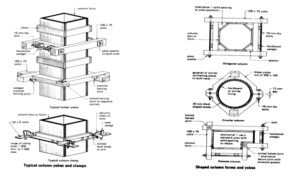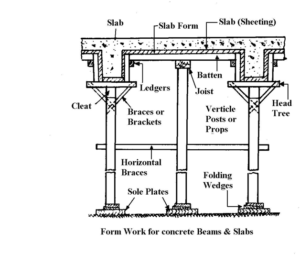It is an artificial support provided below and around the precast or cast in situ concrete work. Form work is commonly made of
- Steel
- wood
Form work construction & casting is of prime importance in concrete industry. It shares a significant amount of concrete cost. (20% to 25%).
When concrete has reached a certain required strength, the form is no longer needed & removed. The operation of removing the form work is known as stripping.
Qualities of form work
It should be according to IS 456-2000.
It should be practically water proof so that it should not absorb water from concrete.
It should be strong.
It can be cheaper & reusable
It should be according to the size of member.It should be with minimum shrinkage & swelling.
It should be stiff enough against it’s deflection, buckling under load.
Its contact surface should be uniform.
It should be light in weight
Types of form work
Form work are mainly of two types
- Steel form work
- Wooden form work
Steel form work is made of
- steel sheets
- Angle Iron
- Tee Iron
Wooden form work consists of
- Props
- Planks battens
- Ledgers
- sheeting
Causes of failure
Overloading of any props when sufficient number or size of props not provided.
Failure of shuttering due to excessive vibrations of needle surface vibrators.
Failure due to improper supervision, inadequate design/ planning of shuttering, cantering & concreting activity.
Failure due to dislocation of props or bracing due to careless movement of labours having access below the form work of slab or beam.
Failure due to insufficient cross bracing. Cross bracing improve the stiffness of props against buckling.
Form work detail for different structural members
In concrete construction form work is commonly provided for the following
Form work detail for different structural members.
Foundations
Wall
Column
Slabs & beams
Stairs
Form work for Foundations
Wall foundations
It consists of
- Plywood Sheeting
- Struts
Formwork for Foundations
Column Foundations
It consists of
- Side Supports
- Side Planks
- Cleats
Form work for Wall
It consists of
- Timber sheeting
- Vertical posts
- Horizontal members
- Rackers
- Stakes
- Wedges
After completing one side of form work reinforcement is provided at the place then the second side form work is provided.
Form work for Column
It consists of the following
- Side & End Planks
- Yoke
- Nut & Bolts
- Two end & two side planks are joined by the yokes and bolts.

Form work for Slabs & beams

It consists of
- Sole plates
- Wedges
- Props
- Head tree
- Planks
- Batten
- Ledgers
- Beam form work rests on head tree
- Slab form work rests on battens and joists
- If prop height are more than 8’ provide horizontal braces.
Form work for Stairs


It consists of
- Vertical & inclined posts
- Inclined members
- Wooden Planks or sheeting
- Stringer
- Riser Planks
Removal of form work
Time of form work removal mainly depends on the following factors
- Type of Cement
- Rapid hardening cements require lesser time as compared to OPC (Ordinary Portland Cement)
- Ratio of concrete mix
- Rich ratio concrete gain strength earlier as compared to weak ratio concrete.
- Weather condition
- Hydration process accelerates in hot weather conditions as compared to cold and humid weather conditions.
Stripping Time of Form work
- Beam sides ,wall & Columns – 1& 2 days as decided by engineer in charge
- Slab soffits ( props left under ) – 3 days
- Beam soffits ( Prop left under ) – 7 days
- Removal of props to slabs:
- a) Spanning up to 4.5 m – 7 days
- b) Spanning over 4.5 m – 14 days
- Removal of props to Beam and Arches:
- a) Spanning up to 6 m – 14 days
- b) Spanning over 6 m – 21 days
Maintenance of form work
- Due to continuous use wooden planks & steel plates surfaces become uneven and require maintenance.
- For wooden form work use cardboard or plastic fiber board. Bolt hole places must also be repaired.
- For steel form work plates must be leveled by mallet and loose corners must be welded.
Cost of form work
- For normal works cost of form work is about 30%-40% of the concrete cost.
- For special works cost of form work is about 50%-60% of the concrete cost.
Form work cost is controlled by the following factors
- Form work Material cost
- Form work erecting cost
- Form work removal cost
- Form work jointing cost (Nails and Cables)
- Labor charges
Advantages of steel form work
- It can be used for a numbers of times.
- It is non absorbent.
- Smooth finish surface obtained.
- No shrinkage of form work occurs.
- Easy to use.
- Its volume is less
- Its strength is more.
